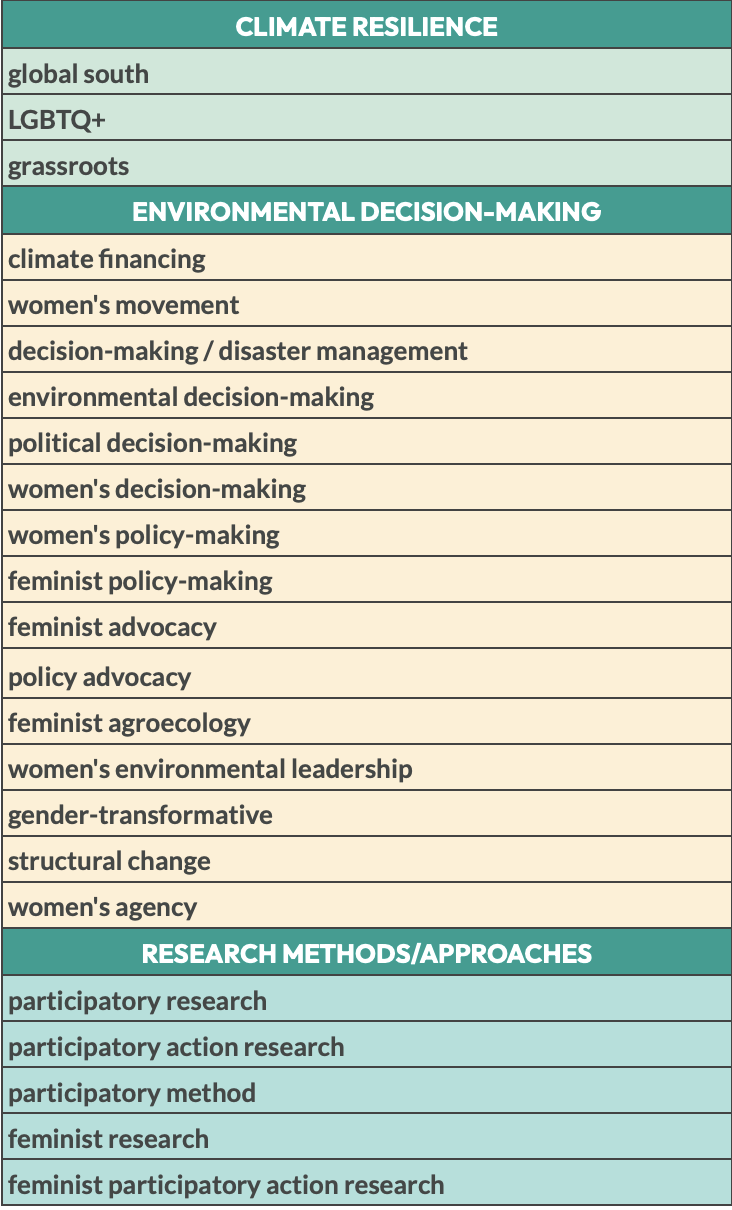Current Trends in Gender-Environment Data
Over the past two decades, we’ve seen a surge in publications investigating the interplay between women/gender and environment/climate change, particularly within the academic sphere (see below). However, access to these academic knowledge products, such as journal articles and books, remains restricted due to high paywall costs, rendering them inaccessible to those outside of academic institutions.
Yearly distribution of publications in academic and gray literature

Figure 1. Represents the amount of publications by year for academic and gray literature.
Word Cloud based on the abstract notes for the literature sample

Figure 2. Represents abstract notes for the literature sample of the research undertaken.
Frequency of priority topics
The following frequency analysis provides an overview of how often key topics related to women’s climate resilience appear prominently in the literature sample of 338 sources.
The analysis focused on priority topics identified by GEDA members as being of particular interest. The frequency is based on keyword searching, tagging, or screening of items in the database.

The findings indicate some topics are understudied. For example, only 4% of sources highlight women’s leadership, 3% use feminist participatory action research, and 2% focus on agroecology. LGBTQ+ is discussed in just 1% of the literature. Supplemental lists of resources are being curated for these areas to address gaps.
Gaps
A preliminary keyword search on WorldCat indicates some overall gaps in the academic literature on women’s climate resilience, especially regarding certain topics and perspectives as listed in the table below:

Few sources were found that examine women’s climate resilience in the Global South or among LGBTQ+ groups specifically. There is limited literature integrating perspectives from grassroots women’s movements.
Additional gaps appear around women’s environmental decision-making capacities, including specific aspects like climate financing, disaster management, policy advocacy, agroecology, and environmental leadership. Structural transformation for gender equality is rarely discussed in conjunction with climate resilience.
Furthermore, there is a need for more research utilizing participatory, feminist, and action-oriented methodologies that center women’s voices and agency. This includes participatory action research and other community-engaged approaches.
While not definitive, this initial keyword search points to areas where more scholarly attention may be warranted to fully capture women’s diverse experiences with climate resilience globally. Further analysis incorporating additional databases could provide greater insight into where knowledge gaps persist.
Geographical focus and research sites
The literature explored delves into gender and environment data across 82 countries spanning all continents.
The geographical concentration of these studies primarily lies within the Global South (mainly low-income and lower-middle-income countries), accounting for 91-92% of the focus, with only 9% focusing on the Global North (high-income countries). The studies were mainly concentrated in Bangladesh (29 studies), India (29 studies), Ghana (22 studies), and Nepal (20 studies).
Based on the regional breakdown of the top 25 most-studied countries, Africa appeared most frequently (110 studies), followed by South Asia (78 studies). Contrastingly, Pacific Island Countries received relatively little attention, indicating a need for further research in this area.
Methodological approaches in the literature
In a review of 338 pieces of academic and non-academic (also called ‘gray’) literature about gender, environment, climate change, disasters, and decision-making, only 106 (or about 31%) clearly stated if they used quantitative methods (on counting and measuring), qualitative methods (understanding experiences and explanations), or a mix of both. We found that nearly half (48%) used only qualitative methods and a good chunk (38%) mixed both qualitative and quantitative methods. Strikingly, a mere 14% of the literature solely relied on quantitative methodology, shedding light on its sparse usage in the reviewed items.
The key data collection methods in the selected literature were interviews (27%) and focus group discussions (21%). Utilization of surveys/questionnaires was more prevalent in academic pieces than the gray literature (18% vs 9%), while case studies was more common in the gray literature (14% vs 9%). Notably, participatory methods, including Feminist Participatory Action Research (FPAR), were applied in 15% of the literature, indicating a trend towards engaging individuals and communities in the data collection process. FPAR in particular was applied in only 3% of the literature.
Feminist methods were used in 9% of the literature, emphasizing the experiences and perspectives of marginalized women. Less frequently used methodologies include gender analysis (4%), lived experience (2%), Photovoice (2%), and innovative methods (1%). Life history approaches, which look at the collection and analysis of events and experiences over the course of individuals’ and communities’ lives, were used in 1% of the items.
This research was conducted through the GEDA Technical Guidance and Data Mapping consultancy led by Trimita Chakma and Bea Moraras, outlined under A Snapshot of Gender-Environment Data. For more information on the consultants, please read their interview for the GEDA Insights Newsletter.